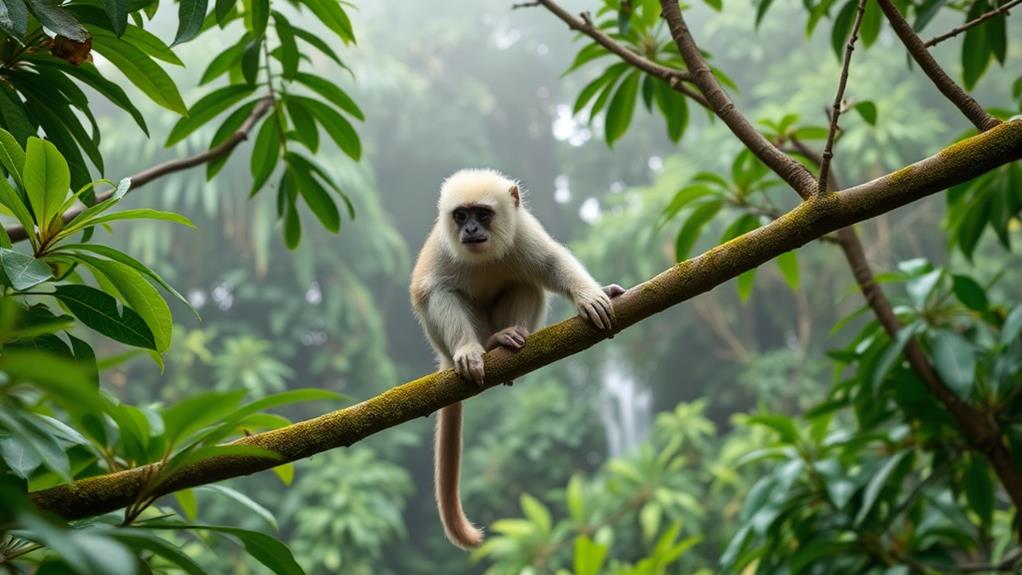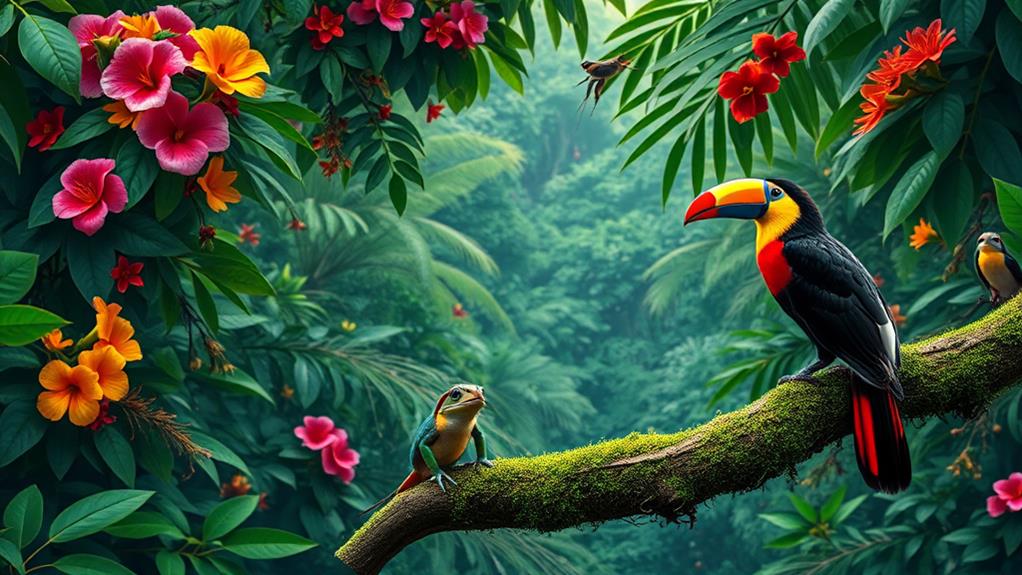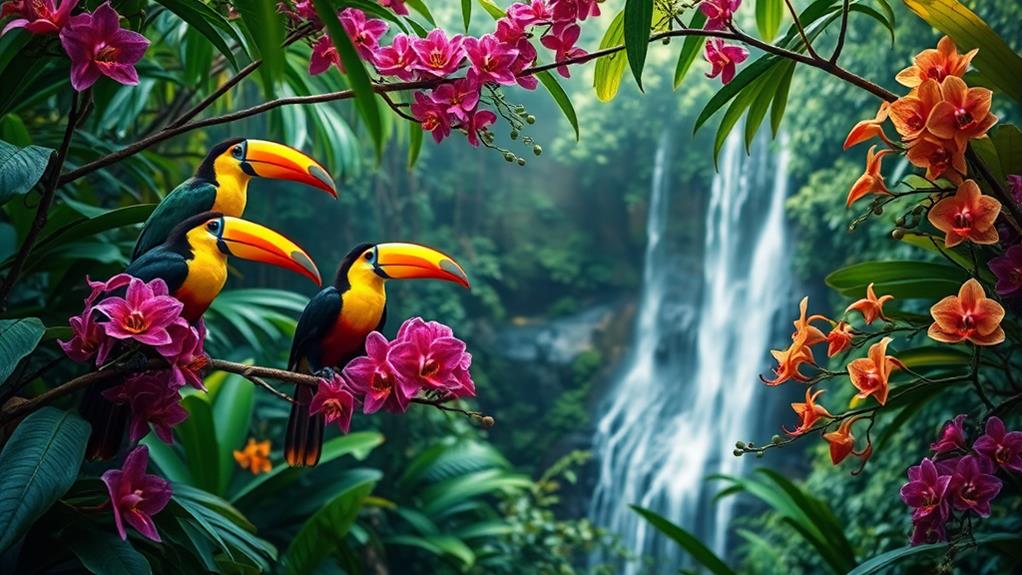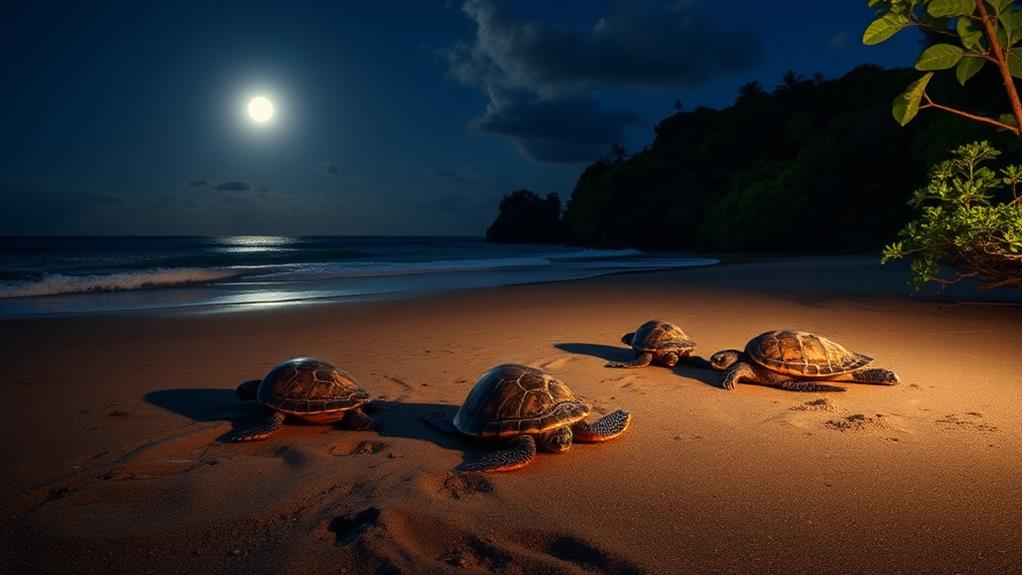Interesting Facts About Costa Rica You Never Knew
You might think you know Costa Rica, but this small Central American country is full of surprises. Did you know that the white-tailed deer is Costa Rica's national animal, not a tropical bird or monkey? Or that it's home to 5% of the world's biodiversity despite occupying only 0.03% of Earth's surface? Costa Rica's coffee, known as "El grano de oro" (the golden grain), has shaped its economy and culture since the 1800s. The country's indigenous heritage, eco-tourism efforts, and unique phenomena like mass sea turtle nesting add to its allure. There's much more to discover about this fascinating nation beyond its beautiful beaches and rainforests.
This post may contain affiliate links. If you make a purchase through these links, I may earn a commission at no additional cost to you. Additionally, portions of this post may be generated using artificial intelligence (AI) technology. While we strive for accuracy, please be aware that AI-generated content may not always be perfect and should be fact-checked when necessary.
The Spatula Scoops
- Costa Rica houses 5% of global biodiversity despite occupying only 0.03% of Earth's surface.
- The country's national animal is the white-tailed deer, featured on the 1,000 colones bill.
- Over 100,000 Olive Ridley sea turtles nest at Ostional Wildlife Refuge, laying up to 10 million eggs annually.
- Walter Ferguson, known as the "Calypso King of Cahuita," significantly influenced Costa Rica's music scene.
- Costa Rica's coffee trade profits contributed to landmarks like the National Theatre in the 1800s.
Costa Rica's Unexpected National Animal

Nature lovers might be surprised to learn that Costa Rica's national animal isn't a colorful toucan or a playful monkey, but the white-tailed deer. This unexpected choice reflects the country's rich biodiversity and cultural heritage. You'll find the deer depicted on the 1,000 colones bill, showcasing its significance in Costa Rican society.
While you're more likely to spot monkeys swinging through the trees, the white-tailed deer plays an essential role in Costa Rica's ecosystem. These elusive creatures inhabit various habitats throughout the nation, contributing to the country's impressive biodiversity. Costa Rica boasts approximately 5% of the world's species, many of which are rare or endangered.
If you're hoping to catch a glimpse of the national animal, you'll need to be patient and observant. The deer's shy nature makes sightings less common than other wildlife. However, national parks like Manuel Antonio and Corcovado offer excellent opportunities for wildlife viewing. When you visit these protected areas, keep your eyes peeled for the white-tailed deer and other fascinating creatures that call Costa Rica home.
Biodiversity Hotspot

You'll be amazed to learn that Costa Rica, occupying just 0.03% of Earth's surface, houses an astounding 5% of the world's biodiversity. This tiny nation's protected areas, covering over a quarter of its territory, are teeming with unique ecosystems and an incredible array of species. From its 27 national parks to its 121 volcanic formations, Costa Rica's varied landscapes provide habitats for countless flora and fauna, including some 750,000 insect species, making it a true biodiversity hotspot.
Tiny Land, Massive Diversity
Packing an incredible punch for its size, Costa Rica is a biodiversity powerhouse. You might be surprised to learn that this small nation, occupying just 0.03% of Earth's surface, is home to an astonishing 5% of the world's biodiversity. That's over 500,000 species of flora and fauna in an area you could easily overlook on a globe.
Costa Rica's commitment to conservation is evident in its 27+ national parks, which protect more than 25% of the country's land. These parks safeguard a wide array of ecosystems and wildlife, from dense rainforests to pristine beaches. The country's geological diversity, including 121 volcanic formations with seven active volcanoes, contributes greatly to its rich biodiversity.
You'll find 12 unique climate zones within Costa Rica's borders, creating a variety of habitats for its remarkable wildlife. This tiny nation's topographical diversity supports an incredible range of species, from colorful tree frogs to elusive jaguars. Costa Rica's dedication to preserving its natural treasures makes it a global leader in conservation efforts, ensuring that future generations can experience its unparalleled biodiversity.
Species-Rich Protected Areas
Within Costa Rica's lush landscapes, you'll discover a treasure trove of biodiversity that's simply staggering. This small Central American nation, covering just 0.03% of the Earth's surface, is home to an astonishing 5% of the world's biodiversity. You'll find over 500,000 recorded wildlife species, including numerous species of hummingbirds, mammals, reptiles, and a vast array of insects.
What's truly remarkable is that more than 25% of Costa Rica's land is designated as protected areas. These sanctuaries, including 30 national parks, play an essential role in preserving the country's rich ecosystems. From cloud forests to rainforests and coastal regions, these diverse habitats support an incredible variety of flora and fauna. The protected areas aren't just significant for conservation efforts; they're also key drivers of eco-tourism, allowing visitors to experience the country's natural wonders firsthand.
Unique Ecosystems Abound
Costa Rica's status as a biodiversity hotspot is truly awe-inspiring. This small Central American country, occupying just 0.03% of Earth's surface, is home to an astonishing 5% of the world's total biodiversity. You'll find over 500,000 species thriving in its diverse landscapes, from lush rainforests to pristine beaches.
The country's unique ecosystems are protected by 27 national parks, each preserving distinct habitats that foster an incredible variety of flora and fauna. Here's what makes Costa Rica's biodiversity so remarkable:
- It boasts 750,000 insect species and 900 bird species, making it a paradise for nature enthusiasts.
- The country features 121 volcanic formations, including seven active volcanoes, which contribute to its rich, diverse landscapes.
- Its 1,228-kilometer coastline encompasses over 300 beaches, supporting a wealth of marine life and ecological zones.
As you explore Costa Rica, you'll encounter an array of ecosystems, from misty cloud forests to vibrant coral reefs. This incredible diversity is a demonstration of the country's commitment to conservation and its role as a global biodiversity hotspot. Whether you're a birdwatcher, marine life enthusiast, or simply a nature lover, Costa Rica's unique ecosystems offer endless opportunities for discovery and appreciation.
Coffee's Golden Legacy

You'll find that Costa Rica's coffee, affectionately known as "El grano de oro" or "the golden grain," has left an indelible mark on the country's culture and economy since the 1800s. This celebrated crop has shaped Costa Rica's agricultural landscape, becoming a cornerstone of its exports and attracting global recognition for its high-quality Arabica beans. From the traditional chorreador brewing method to the coffee-funded National Theatre in San José, you'll see how deeply intertwined coffee is with Costa Rica's national identity and development.
El Grano De Oro
Known as "El grano de oro" or "the golden grain," coffee has been the cornerstone of Costa Rica's economy since the 1800s. Costa Rican coffee, particularly its high-quality Arabica beans, has gained international recognition due to the unique growing conditions found in the country's diverse regions. The coffee industry has played a vital role in shaping Costa Rica's cultural and economic landscape.
When you visit Costa Rica, you'll encounter the rich coffee heritage in various ways:
- Experience traditional brewing methods using a chorreador
- Visit the National Theatre in San José, funded by coffee trade profits
- Explore sustainable coffee farms that prioritize environmental preservation
Coffee's influence extends beyond the cup, as it has greatly contributed to the development of cultural institutions throughout the country. Today, Costa Rica is at the forefront of sustainable coffee practices, ensuring that the industry's rich heritage continues while protecting the environment. As you sip your Costa Rican coffee, you're not just enjoying a delicious beverage; you're partaking in a centuries-old tradition that has shaped the nation's identity and continues to evolve with modern sustainability efforts.
Cultural and Economic Impact
While often celebrated for its rich flavor, Costa Rica's coffee industry has left an indelible mark on the nation's cultural and economic landscape. Since the 1800s, coffee has been a driving force behind Costa Rica's development, earning the nickname "El grano de oro" (the golden grain). You'll find its influence extending beyond agriculture, shaping the country's cultural institutions and economic diversity.
The coffee boom didn't just fill Costa Rican government coffers; it also enriched the cultural landscape. For instance, the National Theatre in San José owes its existence to the prosperous coffee trade. Today, coffee remains an essential part of Costa Rica's agricultural exports, contributing considerably to the economy.
| Aspect | Impact | Example |
|---|---|---|
| Economic | Major export | Substantial portion of agricultural exports |
| Cultural | National identity | "El grano de oro" nickname |
| Environmental | Sustainable practices | Eco-friendly farming methods |
| Tourism | Agritourism | Coffee plantation tours |
As you explore Costa Rica, you'll notice the growing emphasis on sustainable coffee farming. This approach not only secures the industry's longevity but also aligns with the country's commitment to environmental conservation. It's a demonstration of how Costa Rica continues to balance economic growth with cultural preservation and ecological responsibility.
Indigenous Cultural Tapestry

Beneath the lush canopies of Costa Rica's rainforests lies a rich tapestry of indigenous cultures that have shaped the nation's identity for centuries. You'll find eight recognized indigenous groups, including the Boruca and Bribri, which account for about 2% of Costa Rica's population. These groups contribute considerably to the country's cultural heritage and play a crucial role in biodiversity conservation through their sustainable practices and traditional knowledge.
The Indigenous Law of 1977 aims to protect these cultures, preserving their traditions and languages. You can experience this vibrant heritage firsthand through:
- Attending festivals like the Fiesta de los Diablitos
- Participating in chocolate-making workshops
- Visiting indigenous communities to learn about their customs
These experiences not only promote awareness but also support the indigenous communities economically. As you explore Costa Rica, you'll discover how these groups have become integral to the country's environmental stewardship. Their sustainable practices, rooted in centuries of traditional knowledge, continue to inform modern conservation efforts. By understanding and appreciating this indigenous cultural tapestry, you'll gain a deeper insight into Costa Rica's rich and diverse national identity.
Gallo Pinto's Cultural Significance

As you explore Costa Rica's culinary landscape, you'll quickly discover that gallo pinto is more than just a popular breakfast dish. This blend of rice and black beans, whose name translates to "spotted rooster," is Costa Rica's national dish and a true cultural emblem. It's a staple in typical Costa Rican cuisine, reflecting the country's culinary traditions and daily life.
You'll find gallo pinto served across the country, often accompanied by Salsa Lizano, a distinctive sauce that enhances its flavor. Many Costa Ricans start their day with this nutritious meal, viewing it as an energizing breakfast option. As you travel through different regions, you'll notice variations in preparation and serving styles, showcasing local flavors and practices.
| Region | Unique Twist | Local Accompaniment |
|---|---|---|
| Central Valley | Extra cilantro | Fresh cheese |
| Guanacaste | Corn tortillas | Natilla (sour cream) |
| Caribbean Coast | Coconut milk | Plantains |
Gallo pinto's significance extends beyond its taste; it's a symbol of Costa Rican identity and hospitality. By savoring this dish, you're not just enjoying a meal but participating in a cherished cultural tradition that has been passed down through generations.
Calypso King of Cahuita

You'll find Costa Rica's musical heritage beautifully represented by Walter Gavitt Ferguson, known as the "Calypso King of Cahuita." His unique blend of Caribbean rhythms and local influences has not only earned him national and international recognition but has also played an essential role in preserving Costa Rica's cultural identity. The importance of Calypso music was officially acknowledged in 2012, highlighting the country's commitment to safeguarding its rich musical traditions.
Walter Ferguson's Musical Legacy
Costa Rica's rich musical heritage owes much to Walter Ferguson, known as the Calypso King of Cahuita. His contributions to Calypso music, a genre deeply rooted in Costa Rican culture, have left an indelible mark on the country's musical landscape. Ferguson's unique sound and style gained international recognition after his 2002 home recording, showcasing the vibrant essence of Costa Rican Calypso.
The cultural significance of Calypso music was officially acknowledged in 2012 through a special decree, cementing its importance in Costa Rican society. Ferguson's songs often reflect:
- Themes of nature
- Local life experiences
- Community spirit
These elements embody the essence of Costa Rica's Caribbean coast, capturing its beauty and culture through music. Ferguson's musical legacy continues to inspire new generations of musicians, helping to preserve and evolve the Calypso tradition in both local and global music scenes.
You'll find that Walter Ferguson's impact on Costa Rican music extends far beyond his lifetime. His songs serve as a cultural bridge, connecting the past with the present and ensuring that the unique sounds of Costa Rican Calypso continue to resonate with audiences worldwide.
Calypso's Cultural Significance
Many Costa Ricans consider Calypso music to be the heartbeat of their Afro-Caribbean heritage, and Walter Gavitt Ferguson stands as its undisputed king. You'll find that Ferguson's influence on Costa Rica's musical landscape is profound, with his career spanning decades since the 1940s. His songs, deeply rooted in local culture and traditions, have captivated both residents and visitors alike.
In 2002, you might have heard about Ferguson's home-recorded album that brought his vibrant Calypso rhythms to a wider audience. This release helped solidify Calypso's place in Costa Rica's cultural tapestry. The genre's significance was officially recognized in 2012, highlighting its role in expressing the nation's identity.
When you visit Costa Rica, you'll notice that Calypso isn't just music; it's a cultural phenomenon. The lively melodies and storytelling lyrics continue to foster a sense of community through festivals and local performances. As you explore the country, you'll see how Calypso has become an integral part of Costa Rica's Afro-Caribbean heritage, preserving traditions and connecting generations through its infectious rhythms and meaningful narratives.
Recognition and Preservation Efforts
Recognition of Walter Gavitt Ferguson's musical legacy has grown considerably in recent years. Costa Rica's government officially acknowledged his contributions to the country's cultural heritage in 2012 through a special decree. This recognition highlights the importance of Calypso music in shaping the nation's identity and preserving its rich musical traditions.
Efforts to preserve and promote Calypso music in Costa Rica have intensified, focusing on:
- Organizing festivals and events that celebrate the genre
- Recording and archiving traditional Calypso performances
- Educating younger generations about the cultural significance of Calypso
You'll find that Ferguson's music, with its unique blend of Caribbean influences and local traditions, has become a symbol of Costa Rica's diverse cultural tapestry. His songs, often centered on themes of nature and everyday life, resonate with both locals and visitors alike.
The preservation of Calypso music serves multiple purposes. It helps maintain cultural pride, attracts tourists interested in authentic experiences, and guarantees that future generations can appreciate and continue this musical tradition. By recognizing and preserving Calypso, Costa Rica safeguards an essential part of its cultural identity for years to come.
Monteverde's Quaker Roots

Nestled in the heart of Costa Rica's lush landscape, Monteverde's cloud forest owes its preservation to an unexpected source: American Quakers. In 1951, these peace-loving settlers arrived with a mission to protect the region's incredible biodiversity. Their commitment to non-violence, simplicity, and environmental stewardship has shaped Monteverde's development ever since.
You'll find that the Quakers' influence extends beyond conservation. They introduced sustainable farming practices that have evolved to support both local livelihoods and the ecosystem's health. Today, Monteverde boasts over 2,500 plant species and numerous animals, making it a hotspot for eco-tourism.
When you visit, you're not just experiencing natural beauty; you're encountering a living demonstration of the Quakers' vision. The region's emphasis on sustainable practices and environmental education stems directly from their values. As you explore the misty trails and observe the unique cloud forest characteristics, remember that this preserved wonderland exists because of a small group's dedication to harmony with nature. Monteverde's story is a powerful example of how community values can shape and preserve an entire ecosystem.
Year-Round Travel Appeal

Costa Rica's appeal as a travel destination knows no seasonal bounds. You'll find this Central American gem to be an ideal year-round destination, offering diverse experiences regardless of when you visit. Whether you're seeking sun-soaked beaches or lush, verdant landscapes, Costa Rica has something for everyone.
The country's varied climate and topography contribute to its year-round allure:
- Coastal areas maintain warm, tropical temperatures throughout the year
- The Central Valley averages a comfortable 72°F
- Elevations and regions create microclimates, offering diverse experiences
During the peak season (December to April), you'll enjoy sunny weather and bustling tourist activities. However, don't discount the off-peak season (June to November). This "green season" brings lush vegetation and fewer crowds, perfect for eco-tourism activities and wildlife viewing.
Costa Rica's year-round appeal extends beyond weather. You'll find a wealth of experiences no matter when you visit, from zip-lining through rainforests to relaxing on pristine beaches. The country's commitment to conservation guarantees that its natural beauty remains accessible and vibrant throughout the year, making it a top choice for travelers seeking diverse, sustainable experiences.
Eco-Tourism and Conservation Efforts

A cornerstone of Costa Rica's identity and economy, eco-tourism and conservation efforts have transformed the country into a global leader in sustainable travel. You'll find that over 25% of Costa Rica's land is designated as protected areas within national parks, showcasing the nation's commitment to preserving its natural heritage. This dedication to conservation has made Costa Rica a hotspot for eco-tourism, attracting millions of visitors annually who come to explore its diverse ecosystems and wildlife.
With more than 500,000 species of flora and fauna, Costa Rica boasts one of the world's highest levels of biodiversity. To maintain this ecological richness, the country has implemented various reforestation projects to combat deforestation and restore native habitats. These initiatives demonstrate Costa Rica's proactive approach to environmental sustainability.
You'll also notice that education programs and international partnerships play an essential role in enhancing awareness and developing conservation strategies. These efforts focus on protecting endangered species and preserving natural resources for future generations. By visiting Costa Rica, you're not only experiencing its natural wonders but also supporting a nation that prioritizes eco-friendly practices and environmental stewardship.
What Makes Costa Rica Unique Compared to El Salvador?
Costa Rica stands out with its rich biodiversity, eco-tourism, and dedication to renewable energy, offering peaceful surroundings and a lack of standing military. In contrast, el salvador facts highlight its vibrant culture, archaeological treasures, and coffee exports, giving each country unique traits that make them distinct and fascinating in their own ways.
Turtle Nesting Spectacle

On Costa Rica's Pacific coast, you'll find one of nature's most awe-inspiring events: the mass nesting of Olive Ridley sea turtles. At the Ostional Wildlife Refuge, over 100,000 turtles gather during the "arribada," laying up to 10 million eggs from July to September. This spectacle, known as a nesting beach, offers visitors a unique opportunity to witness the turtles' extraordinary life cycle.
Conservation efforts in Costa Rica have led to innovative approaches to protect these magnificent creatures:
- Regulated legal harvesting of turtle eggs in Ostional
- Controlled tourism to minimize disturbance during nesting
- Educational programs to raise awareness about turtle conservation
You'll be amazed by the sheer number of turtles nesting in a single night, creating a breathtaking scene along the coast. If you're interested in seeing more turtle species, head to Tortuguero National Park on the Caribbean side. Here, you can observe different turtle species nesting and even catch sight of hatchlings making their way to the sea. These experiences highlight Costa Rica's commitment to preserving its natural wonders while offering unforgettable eco-tourism opportunities.
Frequently Asked Questions
What Are Some Unusual Facts About Costa Rica?
You'll be amazed to learn that Costa Rica is a biodiversity hotspot, housing 5% of the world's species in just 0.03% of its land area. The country's national dish, gallo pinto, literally means "spotted rooster." With over 200 volcanic formations, Costa Rica's landscape is diverse and dynamic. Notably, they've had no military since 1949, focusing instead on education and healthcare. It's also recognized as a Blue Zone, where people often live longer due to lifestyle factors.
What Is Costa Rica Unique For?
You'll find Costa Rica unique for its extraordinary biodiversity packed into a tiny space. Despite its small size, you'll encounter 5% of the world's species here. You're also stepping into a sustainability leader, with nearly a quarter of its land protected and ambitious carbon-neutral goals. Don't miss the world's largest butterfly observatory, showcasing thousands of species. Finally, you'll experience the "Pura Vida" lifestyle, a laid-back attitude that prioritizes happiness and community well-being, contributing to Costa Rica's high global happiness rankings.
What Are 3 Cultural Facts About Costa Rica?
You'll find Costa Rica's culture rich in unique aspects. First, their "Pura Vida" philosophy embodies a laid-back, positive lifestyle that's central to their identity. Second, Costa Rica boasts a 97% literacy rate, the highest in Central America, thanks to a long-standing commitment to universal education. Finally, their cuisine, like gallo pinto (rice and beans), reflects a blend of indigenous and Spanish influences. These cultural elements showcase Costa Rica's dedication to education, optimism, and culinary traditions.
What Is Costa Rica Most Famous Thing?
Costa Rica's most famous thing is certainly its exceptional biodiversity. You'll find an astonishing variety of flora and fauna in this small Central American country, which hosts about 5% of the world's species. This rich ecosystem, combined with Costa Rica's commitment to conservation, has made it a global leader in eco-tourism. You can explore lush rainforests, pristine beaches, and active volcanoes while observing exotic wildlife in their natural habitats. It's a paradise for nature lovers and adventure seekers alike.





